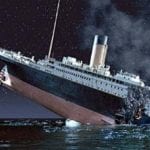 Music
Music  Music
Music  History
History 10 Less Than Jolly Events That Occurred on December 25
 Weird Stuff
Weird Stuff 10 Funny Ways That Researchers Overthink Christmas
 Politics
Politics 10 Political Scandals That Sent Crowds Into the Streets
 Weird Stuff
Weird Stuff Ten Bizarre Facts About The Doge Meme
 Our World
Our World 10 Ways Your Christmas Tree Is More Lit Than You Think
 Movies and TV
Movies and TV The 10 Coolest Stars to Set Sail on The Love Boat
 History
History 10 Things You Didn’t Know About the American National Anthem
 Technology
Technology Top 10 Everyday Tech Buzzwords That Hide a Darker Past
 Humans
Humans 10 Everyday Human Behaviors That Are Actually Survival Instincts
 Music
Music 10 Surprising Origin Stories of Your Favorite Holiday Songs
 History
History 10 Less Than Jolly Events That Occurred on December 25
 Weird Stuff
Weird Stuff 10 Funny Ways That Researchers Overthink Christmas
Who's Behind Listverse?

Jamie Frater
Head Editor
Jamie founded Listverse due to an insatiable desire to share fascinating, obscure, and bizarre facts. He has been a guest speaker on numerous national radio and television stations and is a five time published author.
More About Us Politics
Politics 10 Political Scandals That Sent Crowds Into the Streets
 Weird Stuff
Weird Stuff Ten Bizarre Facts About The Doge Meme
 Our World
Our World 10 Ways Your Christmas Tree Is More Lit Than You Think
 Movies and TV
Movies and TV The 10 Coolest Stars to Set Sail on The Love Boat
 History
History 10 Things You Didn’t Know About the American National Anthem
 Technology
Technology Top 10 Everyday Tech Buzzwords That Hide a Darker Past
 Humans
Humans 10 Everyday Human Behaviors That Are Actually Survival Instincts
10 Famous Brands That Survived Near Bankruptcy
Some of the world’s most recognizable brands weren’t always guaranteed success. While they might seem like permanent fixtures in our everyday lives, many iconic companies faced dark times when bankruptcy or closure seemed inevitable. From risky expansions and changing consumer demands to economic downturns and poor management decisions, these brands were pushed to the brink. Yet, against the odds, they managed to turn things around with smart strategies, product innovations, or sheer perseverance.
In this list, we’ll explore ten famous brands that came dangerously close to disappearing, only to stage remarkable comebacks that redefined their industries.
Related: 10 Shadowy Facts About the Secret Company That Runs the World
10 Apple
Today, Apple is one of the most valuable companies globally, but in the mid-1990s, it was teetering on the edge of bankruptcy. Faced with declining sales, poor product reception, and intense competition from Microsoft, Apple seemed doomed. The company was losing millions, and its stock had plummeted, causing many analysts to doubt its survival. In 1997, Apple was within months of going bankrupt when it took a drastic step by bringing back co-founder Steve Jobs, who had been ousted over a decade earlier.
Jobs introduced a new vision and product line that helped redefine Apple’s brand. The launch of the iMac in 1998 marked the beginning of Apple’s resurgence, followed by the revolutionary iPod in 2001 and the iPhone in 2007. These products reinvigorated the brand and turned Apple into a leader in technology and design. With its focus on innovative, user-friendly products, Apple rebounded from the brink and has since become a symbol of modern technology and design excellence.[1]
9 Marvel Entertainment
Marvel’s superheroes dominate the entertainment world today, but in the mid-1990s, Marvel Entertainment was struggling. The company, which owned the rights to iconic characters like Spider-Man, X-Men, and the Avengers, filed for bankruptcy in 1996. Years of mismanagement, unsuccessful product lines, and a slump in comic book sales left Marvel saddled with debt. The company sold off some of its character rights to movie studios, including Sony and Fox, to generate cash.
In the early 2000s, Marvel took a bold step by creating its own film studio and taking control of its intellectual property. The release of Iron Man in 2008 marked the beginning of the Marvel Cinematic Universe (MCU), which became a massive success. The success of the MCU transformed Marvel into an entertainment powerhouse, eventually leading to its acquisition by Disney in 2009. Today, Marvel is one of the most profitable brands in the entertainment industry, with its characters appearing in blockbuster films, TV shows, and merchandise worldwide.[2]
8 Lego
Lego, the beloved toy brand, was on the verge of collapse in the early 2000s. The company expanded too quickly in the 1990s, launching numerous new product lines, theme parks, and other ventures that failed to generate expected revenue. By 2004, Lego was nearly $800 million in debt, with many analysts predicting its downfall. The company struggled to adapt to digital-age competition and faced declining sales as kids turned to video games.
Lego’s turnaround began when the company refocused on its core product—bricks. It introduced popular themed sets like Star Wars, Harry Potter, and Ninjago, capitalizing on existing fan bases. The company also embraced digital initiatives, such as Lego video games and movies, bringing the brand to new audiences. The 2014 release of The Lego Movie reignited global interest in Lego, proving that the brand could adapt to modern entertainment demands. Today, Lego is one of the world’s most successful toy companies, proving the power of creative rebranding and strategic focus.[3]
7 Converse
Converse shoes, particularly the Chuck Taylor All-Stars, are iconic today, but in the early 2000s, the brand was facing severe financial troubles. Despite its historical popularity, Converse struggled with changing fashion trends and increased competition from brands like Nike and Adidas. In 2001, Converse filed for bankruptcy, and it looked like the brand might disappear altogether after nearly a century in business.
In 2003, Nike acquired Converse and revitalized the brand with a focus on heritage and modern appeal. Nike leveraged Converse’s retro style, reintroducing the classic Chuck Taylors with updated designs and collaborations with popular designers and artists. This move repositioned Converse as a fashionable, vintage-inspired brand that appealed to younger audiences. Since then, Converse has become a staple in fashion and streetwear, proving that a historic brand can find new life with the right approach.[4]
6 Netflix
Today, Netflix is a streaming giant, but in its early days, it was nearly pushed out of the market by Blockbuster. Founded in 1997 as a DVD rental service, Netflix struggled to compete with Blockbuster’s physical stores. In 2000, Netflix offered to sell itself to Blockbuster for $50 million, but Blockbuster declined. As DVD rentals declined, Netflix faced the possibility of running out of business.
Instead, Netflix adapted by pivoting to streaming in 2007, marking a major turning point. As consumer demand shifted towards digital streaming, Netflix capitalized on the trend and began producing original content, starting with House of Cards in 2013. Its shift to streaming and original programming catapulted Netflix to the forefront of the entertainment industry, and today, it’s a leader in on-demand streaming worldwide.[5]
5 General Motors
General Motors (GM), one of the most iconic American automakers, filed for bankruptcy in 2009 during the global financial crisis. Facing plummeting sales, massive debt, and a reputation for producing fuel-inefficient vehicles, GM was unable to survive the economic downturn. The U.S. government stepped in with a $50 billion bailout, and GM underwent a complete restructuring, selling off brands and closing plants.
The bailout helped GM rebuild its reputation, and the company focused on producing more efficient, high-quality vehicles to regain consumer trust. By shifting to innovative products like the Chevrolet Volt, one of the first mainstream electric cars, GM adapted to changing consumer demands. Today, GM remains a key player in the automotive industry, proving that even the most established brands can bounce back with the right support and strategy.[6]
4 Airbnb
Airbnb, now synonymous with short-term rentals, faced a rocky start after its launch in 2008. Founders Brian Chesky and Joe Gebbia struggled to secure funding, and by 2009, they were drowning in debt. Airbnb tried multiple tactics to raise money, including selling cereal called “Obama O’s” and “Cap’n McCain’s” during the 2008 U.S. election. Despite these efforts, the company was on the brink of bankruptcy until a breakthrough in 2009, when it secured funding from Y Combinator.
The investment allowed Airbnb to refine its business model and expand globally. The brand gained traction as an affordable alternative to hotels, and by focusing on user experience and unique properties, Airbnb created a new category in the travel industry. Today, Airbnb is valued at billions, providing millions of hosts and travelers with innovative accommodation options worldwide.[7]
3 Best Buy
Best Buy, the electronics retailer, struggled in the early 2010s as it faced fierce competition from online retailers like Amazon. Sales declined, and the company’s “big-box” store format felt outdated in a digital-first world. Best Buy’s profits plummeted, and it was on the verge of bankruptcy in 2012, with many analysts predicting its imminent demise.
Under new CEO Hubert Joly, Best Buy implemented a turnaround strategy focused on improving customer service, matching Amazon’s prices, and revamping stores to emphasize tech support and in-store experiences. The company also established partnerships with tech giants like Apple and Samsung, creating “store-within-a-store” experiences. These initiatives helped Best Buy regain profitability and adapt to the e-commerce era, transforming it into a rare brick-and-mortar retail success story.[8]
2 IBM
IBM was once the undisputed leader in computing, but by the 1990s, the company was struggling to keep up with the rapidly evolving tech industry. With the rise of personal computers, IBM’s mainframe-centric business model became outdated, and the company posted significant financial losses. By 1993, IBM was on the verge of bankruptcy and had to lay off tens of thousands of employees.
IBM’s turnaround came when it shifted from hardware manufacturing to software and consulting services, focusing on technology solutions for businesses. The company pivoted towards artificial intelligence and cloud computing, investing heavily in these emerging technologies. Today, IBM is a major player in enterprise computing, and its transformation has allowed it to remain relevant in an industry marked by rapid change.[9]
1 Nintendo
Nintendo, a household name in gaming, faced financial troubles in the early 2000s as competition from Sony’s PlayStation and Microsoft’s Xbox threatened its market position. Sales of Nintendo’s GameCube console lagged behind competitors, and the company was struggling to capture a wider audience. By 2004, analysts were questioning whether Nintendo could survive as a console maker.
Nintendo responded by shifting its focus to more innovative and accessible gaming. The launch of the Nintendo DS in 2004 and the Wii in 2006, with its motion-sensing technology, broadened Nintendo’s appeal to casual gamers and families. Both consoles became massive successes, redefining gaming as an inclusive, family-friendly experience. Nintendo’s comeback solidified its reputation as an innovative leader in gaming, with the company later launching the wildly popular Switch console.[10]








